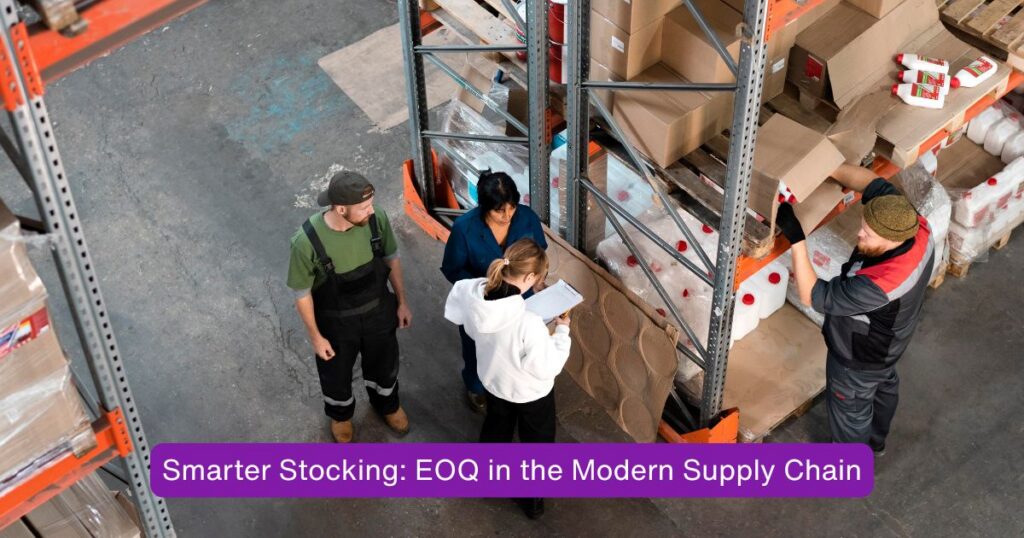
Warehouses today aren’t just places to store inventories. It’s a key part of how products move from makers to suppliers to customers. Whether on the same day, physical delivery for online shopping, or real-time parts for a factory. How you manage your inventory affects everything. Checking the costs of your inventory or timing of delivery, as well as customer satisfaction, needs to be addressed; this is where EOQ works. It’s a simple idea that steps in to help your teams and make smarter decisions about how much to order and when.
What Is EOQ?
EOQ stands for Economic Order Quantity. Identifies the most cost-efficient amount of stock to order. The goal is to hit the balance between two things: ordering costs and storage costs.
- Ordering costs include paperwork, shipping charges, and the effort that goes into placing an order.
- Holding or storage costs come from storing the inventories, like warehouse rent, stock insurance, and even the risk that items get old or go out of date.
Ordering too often means paying more in admin and shipping. Huge bulk buys inflate holding costs.
Here’s the Formula of EOQ
Were,
- D = Annual demand (units)
- S = Ordering cost per order
- H = Holding cost per unit per year
Let’s say, a company needs 10000 units a year and it costs 50 bucks to order and two bucks to store each item. The formula tells you to order around 707 units at a time to keep costs down and things moving smoothly.
Therefore, it will be –
EOQ = √ (2x 10000x 50 / 2)
It will come √ (500000). If we square root 500000, it will be 707 (Approx.)
That means the company is required to order 707 quantities each time to save or minimise both the storage cost and holding cost.
Why EOQ Still Works in 2025?
In today’s time, we have smart tech and AI tools that make predictions. IoT (Internet of Things) tracks items in real time. But EOQ still matters because of its solid foundation.
- AI makes EOQ more precise.
- Eco goals now include carbon in storage costs.
- Multiple warehouses use EOQ to stay balanced.
- Resilient planning adjusts EOQ when things get unpredictable.
Therefore, it’s not yet an old-school thing; it has just evolved.
EOQ in Warehouse Training
Here’s where EOQ connects directly to the warehouse floor. Warehouse Training programs that integrate EOQ help staff understand not just what they do, but why they do it.
Inventory Awareness: New hires see how consistent order sizes reduce chaos.
Space & Safety: Predictable shipments mean better slotting and safer handling.
Receiving & put away: Standardised orders streamline training, so routines stick.
Picking Efficiency: Balanced stock levels make replenishment cycles smoother.
Big-Picture Thinking: EOQ shows how warehouse work links to finance and customer experience.
By teaching EOQ principles alongside technical tasks, training goes beyond forklifts and barcodes—it builds smarter, business-aware teams.
A Fresh Look at a Classic EOQ Idea
Think of EOQ like a vinyl effect in the whole supply chain management. Economic Order Quantity can now be managed in a classic and advanced manner with the help of digital tools. EOQ is now being used alongside AI forecasts, blockchain tracking, and green shipping methods. The result? Inventory strategies that are lean, green, and tech-driven —yet still grounded in the fundamentals.
Final Takeaway
EOQ might be a traditional technique used for over a hundred years, but it still helps businesses and inventory managers today handle their inventories. For warehouse teams, it adds structure, workability, and training for daily operations. In other words, every new supply chain management tool and trend will come and go, but EOQ will keep things steady. Which is always helpful in innovative stock management, reduces inventory management cost, and makes stock move faster.

Leave a Reply